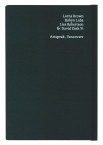Artspeak
-
Lorna Brown is a visual artist, writer, educator and editor, exhibiting her work internationally since 1984. Brown was the Director/Curator of Artspeak Gallery from 1999 to 2004 and is a founding member of Other Sights for Artists’ Projects, a collective of artists, architects and curators presenting projects that consider the varying conditions of public places and public life. She has taught at Emily Carr University of Art and Design and Simon Fraser University. Brown received an honorary degree from Emily Carr University of Art and Design (2015), the Vancouver Institute for the Visual Arts Award (1996) and the Canada Council Paris Studio Award (2000). Her work is in the collections of the Morris and Helen Belkin Art Gallery, the National Gallery of Canada, the BC Arts Council, the Surrey Art Gallery and the Canada Council Art Bank.
Director/Curator of Artspeak 1999–2004.
-
Robyn Laba is a Vancouver based artist. Since receiving her BA in Art History and Studio Art from the University of British Columbia in 1998, she has had solo exhibitions at the Or Gallery, Vancouver and her work has been included in group exhibitions at the Vancouver Art Gallery and Charles H. Scott Gallery, Vancouver.
-
Lisa Robertson is a poet currently based in France. Recent books include Occasional Work and Seven Walks From The Office For Soft Architecture: Essays, Toronto (Coach House Books, 2006), The Men, Toronto (Bookthug, 2006); Occasional Works and Seven Walks from the Office for Soft Architecture, Astoria (Clearcut Press, 2003); Doubt, Vancouver (Artspeak, 2002); The Weather, Vancouver (New Star Books, 2001); Soft Architecture: A Manifesto, Vancouver and Montreal (Artspeak and Dazibao). She teaches at the California College of the Arts.
-
David Zink Yi was born in 1973 in Lima and lives in Berlin. His work has been shown internationally, including solo exhibitions at Museum Ludwig, Cologne; Kunstlerhaus Bremen; Johann Konig, Berlin; Hauser & Wirth, Zurich; and in group exhibitions at Bronx Museum of Art; CCA Wattis Institute; Kunstverein Dusseldorf Rheinlande und Westfalen; Kunsthalle Mannheim; and Manifesta 5, among others.
Exhibitions
-
LORNA BROWN, DAVID ZINK YI
April 7–May 12, 2007It has been noted that the Age of Information is, in fact, an age of forgetting: we are inundated with a culture so overwhelming that it hurtles past us without remark, unabsorbed. This flood might be called cultural chatter. One of the results of the waves of information is boredom, a lack of curiosity in the face of the sheer magnitude of things and ideas in the world. A nod to Theodor Adorno’s discussions of the culture industry, leisure, and the “chatter of culture,” this exhibition brings together the work of two artists that approach the thematics and anatomy of world-weariness.
Lorna Brown’s ongoing research into boredom has informed her recent visual and critical practice. The Structure of Boredom (After Oden) is a work that endlessly repeats an analytic diagram, mapping boredom’s characteristics of repetition, predictability, and temporal suspension. Installed in Artspeak’s windows, it functions not only as analysis, but as decorative hoarding or perhaps lolling dance step instructions. Brown’s video Threshold (cont.) projects an archive of rolling quotes on boredom that spills over the floor and up the wall like cinematic credits. The quotes complicate and contradict one another as they struggle to communicate. The use of text elicits a layering of histories. From the inception of the printed word through modern literature, theory, and into the age of Hollywood and digital communication technologies such as texting and Powerpoint, the work incites a consideration of the conditions of obsolescence in tandem with the conditions of boredom.
David Zink Yi’s practice offers reflections on the hybrid character of cultural and personal histories, often depicting the body as an instrument or medium of both the individual and the collective. His video Ahumm is a short verbal, visual, and physical meditation in which a figure is shown writing variations of the expression “ahumm” on a piece of paper while intoning the expressions. It is unclear if the actions are synchronous and the actions reflect an emotionality that is at once personal and distant. The performative activity of the figure takes place in real time (but in its looping this “real time” is suspended), unlike the Hollywood structure of the film credits in Brown’s work. The work contains a tension between passivity and action, conceptualism and body politics. The works in The Chatter of Culture are potentially on the threshold between pessimism and hopefulness, at once frustrating and contradictory, meaningful and on the brink of illumination.
Postscript 27: Rebecca Marks on The Chatter of Culture (PDF)
Publications
The Chatter of Culture
Title: The Chatter of Culture
Category: Exhibition Catalogue
Artist: Lorna Brown, Robyn Laba, David Zink Yi
Writers: Lisa Robertson, Melanie O’Brian
Editor: Melanie O’Brian
Design: Jeff Khonsary
Publisher: Artspeak
Printer: Hignell Book Printing
Year published: 2008
Pages: 52pp
Cover: Hardcover
Binding: Perfect Bound
Process: Offset
Features: 12 b&w images, 9 colour images
Dimensions: 20 x 14 x 1 cm
Weight: 173 g
ISBN: 978-0-921394-56-3
Price: $7 CDN
A nod to Theodor Adorno’s discussions of the culture industry, leisure, and the “chatter of culture,” this publication brings together works that approach the anatomy of world-weariness. The works simultaneously reveal cultural overload to be curiosity-crushing as well as breeding grounds for new ideas. It has long been argued that (successful) art sustains curiosity and speculation rather than answers questions or provides conclusions, as scientific information intends to do. The publication assembles the documentation of two exhibitions held at Artspeak in 2007 that included the work of Lorna Brown, Robyn Laba, and David Zink Yi with a new poem by Lisa Robertson, About 1836 (an essay on boredom). Robertson was invited to write in consort with the themes of the exhibitions. The works represented here centre around investigations into cultural chatter, edging towards an articulation of a subjective yet social phenomenon.

